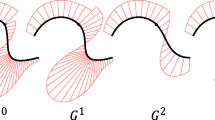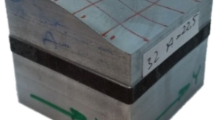Abstract
A ball-end cutting tool is usually chosen to mill free-form surfaces in finishing operations. The cutting speed, which is calculated considering the nominal tool diameter, reduces along the tool path, according to tool-surface contact and the effective tool diameter. This brings several drawbacks to the manufacturing process. The current work presents a new algorithm to optimize CNC codes for milling free-form surfaces by parametrizing and adjusting the spindle frequency and the feed rate, considering the tool-surface contact. The proposed algorithm introduces new values for spindle frequency (S) and for feed rate (F) at each line of the CNC code, according to the surface topography. Machining experiments show that the proposed algorithm can reduce the milling time up to 40%, as well as reduce the machining force up to 21%, compared to the ordinary CNC codes. By kee** the cutting speed and feed rate constant, the surface roughness was improved—confirmed by ANOVA analysis—due to the increased shear mechanism rather than ploughing, especially in areas where the effective tool diameter is smaller.

















Similar content being viewed by others
References
Chen T, Shi Z (2008) A tool path generation strategy for three-axis ball-end milling of free-form surfaces. J Mater Process Technol 208:259–263. https://doi.org/10.1016/j.jmatprotec.2007.12.142
de Souza AF, Diniz AE, Rodrigues AR, Coelho RT (2014) Investigating the cutting phenomena in free-form milling using a ball-end cutting tool for die and mould manufacturing. Int J Adv Manuf Technol 71:1565–1577. https://doi.org/10.1007/s00170-013-5579-4
Aspinwall DK, Dewes RC, Ng EG et al (2007) The influence of cutter orientation and workpiece angle on machinability when high-speed milling Inconel 718 under finishing conditions. Int J Mach Tools Manuf 47:1839–1846. https://doi.org/10.1016/j.ijmachtools.2007.04.007
Wojciechowski S, Wiackiewicz M, Krolczyk GM (2018) Study on metrological relations between instant tool displacements and surface roughness during precise ball-end milling. Measurement 129:686–694. https://doi.org/10.1016/j.measurement.2018.07.058
Krajnik P, Kopač J (2004) Modern machining of die and mould tools. J Mater Process Technol 157–158:543–552. https://doi.org/10.1016/j.jmatprotec.2004.07.146
Fan J (2014) Cutting speed modelling in ball nose milling applications. Int J Adv Manuf Technol 73:161–171. https://doi.org/10.1007/s00170-014-5672-3
Choi BK, Jerard RB (1998) Sculptured surface machining: theory and applications, First edn. Kluwer Academic Publishers, The Netherlands
Ma JW, Song DN, Jia ZY et al (2018) Tool-path planning with constraint of cutting force fluctuation for curved surface machining. Precis Eng 51:614–624. https://doi.org/10.1016/j.precisioneng.2017.11.002
Wan M, Ma YC, Feng J, Zhang WH (2016) Study of static and dynamic ploughing mechanisms by establishing generalized model with static milling forces. Int J Mech Sci 114:120–131. https://doi.org/10.1016/j.ijmecsci.2016.05.010
Tuysuz O, Altintas Y, Feng HY (2013) Prediction of cutting forces in three and five-axis ball-end milling with tool indentation effect. Int J Mach Tools Manuf 66:66–81. https://doi.org/10.1016/j.ijmachtools.2012.12.002
de Souza AF, Berkenbrock E, Diniz AE, Rodrigues AR (2015) Influences of the tool path strategy on the machining force when milling free form geometries with a ball-end cutting tool. J Braz Soc Mech Sci Eng 37:675–687. https://doi.org/10.1007/s40430-014-0200-9
de Lacalle LNL, Lamikiz A, Sánchez JA, Salgado MA (2007) Toolpath selection based on the minimum deflection cutting forces in the programming of complex surfaces milling. Int J Mach Tools Manuf 47:388–400. https://doi.org/10.1016/j.ijmachtools.2006.03.010
Salami R, Sadeghi MH, Motakef B (2007) Feed rate optimization for 3-axis ball-end milling of sculptured surfaces. Int J Mach Tools Manuf 47:760–767. https://doi.org/10.1016/j.ijmachtools.2006.09.011
Erkorkmaz K, Layegh SE, Lazoglu I, Erdim H (2013) Feedrate optimization for freeform milling considering constraints from the feed drive system and process mechanics. CIRP Ann Manuf Technol 62:395–398. https://doi.org/10.1016/j.cirp.2013.03.084
Park HS, Qi B, Dang DV, Park DY (2018) Development of smart machining system for optimizing feedrates to minimize machining time. J Comput Des Eng 5:299–304. https://doi.org/10.1016/j.jcde.2017.12.004
Kim KK, Kang MC, Kim JS et al (2002) A study on the precision machinability of ball end milling by cutting speed optimization. J Mater Process Technol 130–131:357–362. https://doi.org/10.1016/S0924-0136(02)00824-5
Vavruska P, Zeman P, Stejskal M (2018) Reducing machining time by pre-process control of spindle speed and feed-rate in milling strategies. Procedia CIRP 77:578–581. https://doi.org/10.1016/j.procir.2018.08.216
Seguy S, Insperger T, Arnaud L et al (2010) On the stability of high-speed milling with spindle speed variation. Int J Adv Manuf Technol 48:883–895. https://doi.org/10.1007/s00170-009-2336-9
Scandiffio I, Diniz AE, de Souza AF (2016) Evaluating surface roughness, tool life, and machining force when milling free-form shapes on hardened AISI D6 steel. Int J Adv Manuf Technol 82:2075–2086. https://doi.org/10.1007/s00170-015-7525-0
Phadke MS (1989) Quality engineering using robust design. Prentice-Hall, Englewood Cliffs
Merchant ME (1945) Mechanics of metal cutting process. J Appl Phys 16:267–275
Piispanen V (1937) Eripaines Teknilliseslä Aikakauslehdeslä
Albrecht P (1960) New developments in the theory of the metal-cutting process. Part I. The ploughing process in metal cutting. Trans ASME 82:348–356. https://doi.org/10.1115/1.3664242
De Oliveira FB, Rodrigues AR, Coelho RT, De Souza AF (2015) Size effect and minimum chip thickness in micromilling. Int J Mach Tools Manuf 89:39–54. https://doi.org/10.1016/j.ijmachtools.2014.11.001
Batista MF, Rodrigues AR, Coelho RT (2017) Modelling and characterisation of roughness of moulds produced by high-speed machining with ball-nose end mill. Proc Inst Mech Eng B J Eng Manuf 231:933–944. https://doi.org/10.1177/0954405415584898
de Assis CLF, Jasinevicius RG, Rodrigues AR (2015) Micro end-milling of channels using ultrafine-grained low-carbon steel. Int J Adv Manuf Technol 77:1155–1165. https://doi.org/10.1007/s00170-014-6503-2
Author information
Authors and Affiliations
Corresponding author
Additional information
Publisher’s note
Springer Nature remains neutral with regard to jurisdictional claims in published maps and institutional affiliations.
Electronic supplementary material
ESM1
(PDF 156 kb)
Rights and permissions
About this article
Cite this article
Käsemodel, R.B., de Souza, A.F., Voigt, R. et al. CAD/CAM interfaced algorithm reduces cutting force, roughness, and machining time in free-form milling. Int J Adv Manuf Technol 107, 1883–1900 (2020). https://doi.org/10.1007/s00170-020-05143-x
Received:
Accepted:
Published:
Issue Date:
DOI: https://doi.org/10.1007/s00170-020-05143-x




